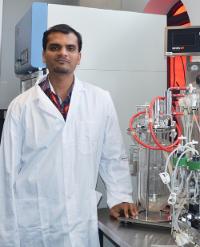The country is the world’s sixth largest wine producer, with around 1.75m tonnes of grapes crushed for wine every year.
After the final pressing, more than half of the grapes crushed end up as biomass waste (as skins, pulp, stalks and seeds).
Researchers at Swinburne University of Technology in Melbourne have developed a technique for converting this woody material (cellulose, pectins and lignin) into simpler compounds. This could be then used to create ethanol or other biofuels.
Reducing landfill waste
So far, the technique has been carried out in the laboratory. But Avinash Karpe, who has been investigating the process as part of his PhD research, told BeverageDaily.com the process could be scaled up on an industrial scale.
“One of the major issues with wineries is the disposal of their grape wastes after pressing for wine production,” he said. “Unlike the biomass wastes from barley and wheat, there are very few applications of winery waste, so the majority of waste ends up in landfill.
“Recently, the European Union has categorised this waste as an industrial pollutant, highlighting the environmental issues this waste creates and the necessity to produce quickly evolving methods for its treatment.”
Fungi cocktail
The researchers use fungi to generate enzymes, and the enzymes then convert biomass waste to soluble sugars, which can be made into other products.
Using a ‘cocktail’ of four fungi – Trichoderma harzianum, Aspergillus niger, Penicillium chrysogenum and Penicillium citrinum, in a one litre bioreactor, Karpe can break down grape biomass, with an increase in enzyme activity and lignin degradation.
This fermentation process takes one to three weeks and produces alcohols, acids and simple sugars of industrial and medicinal interest.

Designed with wineries in mind
Karpe said the technique is currently focused on pilot scale R&D with potential commercial outputs. However, he is interested in developing the research on larger scale alongside winemakers in Australia.
“One of the primary challenges is maintaining laboratory scale conditions on large batches (hundreds of tonnes) of winery biomass waste while minimising the costs," he said.
As an example, maintaining the necessary temperature could be costly.
“To resolve this, we have successfully worked on production of symbiosis between our working fungi and heat-tolerant bacteria," he said. "This process eliminated the necessity for a temperature control mechanism, thus saving considerable energy and costs involved.
“When we started this project, we had considered the levels of input costs generally involved in wine making and other processes of a standard winery. Therefore, the methodologies were developed to keep the overall process as economic as possible.
"For example, the fungi and chemicals we used are widely available and inexpensive to grow.
“There are some input costs involved in processing this waste. However, we are certain that these costs are a fraction of those involved in waste treatments in numerous other chemical and biological processing industries.”
